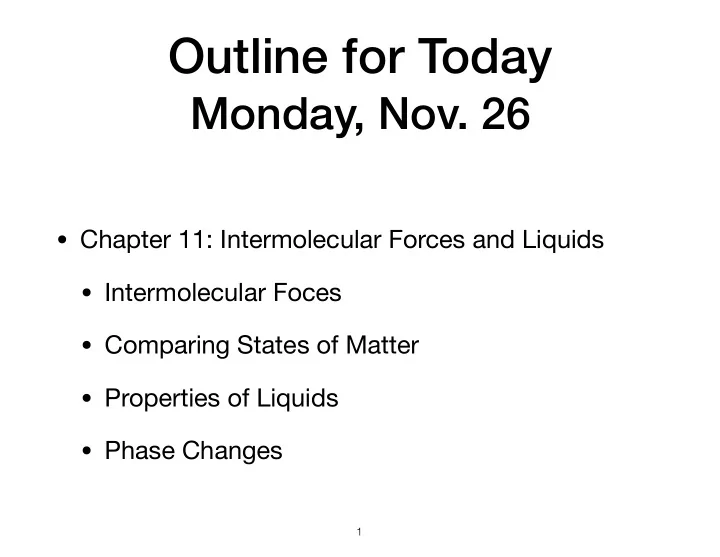

Outline for Today Monday, Nov. 26 • Chapter 11: Intermolecular Forces and Liquids • Intermolecular Foces • Comparing States of Matter • Properties of Liquids • Phase Changes � 1
Exam 3 Reminders • When: Wednesday at 5pm • Where: First floor of Keyes • What: Cumulative with a focus on chapters 6 through 9 • Review Session Tonight 7-9pm Keyes 105
Chapter 6: Electronic Structure of Atoms • There are 4 equations related to the wave behavior of light and matter, know when and how to use them! • Know the rules for the quantum numbers and how they relate to orbital shapes and number of nodes. • Be able to write electron configurations for all elements. • Don’t forget: there are 4 exceptions to the electronic configuration patterns (Cr, Cu, Ag, Au)
Chapter 7: Periodic Trends • There are 4 periodic trends we discussed. • Z E ff , sizes of atoms and ions, ionization energy, and electron a ffi nity. • You should know the definitions, trends, and reasons why each trend occurs. • You should be able to rationalize exceptions based on electron configurations.
Chapter 8: Chemical Bonding • Identify Ionic Bonding and Lattice Energy • Lewis Structures • Formal Charge • Bond Polarity and Trends in Electronegativity • Resonance structures and exceptions to the octet rule • Calculations using Bond Enthalpy
Chapter 9: Molecular Geometry and Bonding Theories • Three dimensional molecular shapes (Tables 9.1 through 9.4) • Orbital Hybridization and Multiple bonds • Molecular Polarity (REALLY IMPORTANT for Chapter 11!) • Molecular orbital theory for 1st and 2nd row diatomic (figure 9.43) • Bond Order and Paramagnetic/Diamagnetic
A Brief Review of Polarity and Dipole Moments • Draw a Lewis Structure of CF 2 I 2 . • Is it Polar or Nonpolar?
Chapter 11: Intermolecular Forces and Condensed Phases (Liquids and Solids)
Why does the water droplet bead up on the lotus leaf? Why doesn’t it spread out? The waxy molecules coating the lotus leaf are di ff erent than the water! They are Hydrophobic! Why? Intermolecular Forces! (The waxy lotus leaves lack hydrogen bonding!)
Intermolecular Forces are the Forces of INTERACTING Molecules Strongly Weakly Interacting. Cl 2 Br 2 I 2 Interacting. Strong Weak Gas Liquid Solid Intermolecular Intermolecular Forces Forces
Intermolecular Forces • Intermolecular Forces= The attractive forces between molecules
Intermolecular Forces Generally Weaker • London Dispersion : Attraction between momentary or instantaneous dipoles in molecules. • Dipole-Dipole : Attraction between partial charges due to permanent dipoles • Hydrogen-Bonding : Attraction between partial charges on H-F , H-O, or H-N bonds. • Ion-Dipole : Attraction between ions and partial charges of dipoles Generally Stronger
Intermolecular Forces Which Molecules? • London Dispersion : Attraction between All Molecules momentary or instantaneous dipoles in van der molecules. Waals forces • Dipole-Dipole : Attraction between partial Polar Molecules charges due to permanent dipoles • Hydrogen-Bonding : Attraction between Needs H attached to O, N, or F partial charges on H-F , H-O, or H-N bonds. • Ion-Dipole : Attraction between ions and Needs an Ion partial charges of dipoles
London Dispersion
Strength of London Dispersion Forces depends on Polarizability • Polarizability : How easy it is to alter the electron density of a molecule (how sloshy the electrons is) • Polarizability tends to increase with the number of electrons (roughly molecular weight). • Example: Order the following molecules from most polarizable to least: • F 2 , I 2 , Cl 2 • SnH 4 , SiH 4 , CH 4
Stronger the Intermolecular Force, the Higher the Boiling Point Temperature! • Example: Sort the following by increasing Boiling Point Temperature • H 2 Te, H 2 S, H 2 Se
London-Dispersion Depends on Shape Same Molecular Weight, Di ff erent Shapes Di ff erent Boiling Points
Dipole-Dipole • Dipole-Dipole: Attraction between partial charges due to permanent dipoles. • Example: Is there a dipole on CH 3 CN? • How do the dipoles interact?
Dipole-Dipole Interactions in Solids
Dipole Dipole Interactions in Liquids
The larger the dipole, the stronger the dipole-dipole interactions! O O N Increasing Polarity Increasing Dipole-Dipole Interactions Increasing Boiling Point
Hydrogen-Bonding is a special type of dipole interaction • Hydrogen-Bonding : Attraction between partial charges on H-F , H-O, or H-N bonds. • H-F , H-N, and H-O are especially polar bonds! • They interact strongly with small electronegative ions or atoms (like F , O, or N of another molecule). • That interaction is called hydrogen bonding.
NOT A Hydrogen Bond H H H C H H C H H H Yes, there are hydrogens bonded to stu ff , but there is no intermolecular hydrogen bonding interaction . There is no hydrogen bond.
Hydrogen Bonding Is Critical for Understanding the Properties of Water!
Predict the relative strengths of the dipole-dipole interactions • Order the following by increasing boiling point (based on strength of the intermolecular interactions) O O c) 2-Methylpropane a) Butane b) Propyl alcohol d) Isopropyl alcohol
Intermolecular Forces with Charged Particles • Ion-Dipole Forces : Attraction (or Repulsion) between an ion and the partial charge on the end of a molecule
Try this chart with: Ammonia, Methane, Acetic Acid, Hydrochloric Acid
Recommend
More recommend